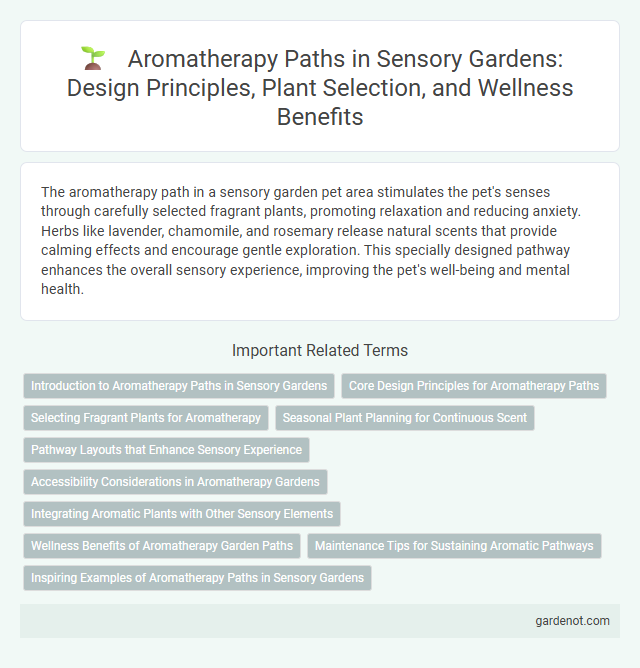The aromatherapy path in a sensory garden pet area stimulates the pet's senses through carefully selected fragrant plants, promoting relaxation and reducing anxiety. Herbs like lavender, chamomile, and rosemary release natural scents that provide calming effects and encourage gentle exploration. This specially designed pathway enhances the overall sensory experience, improving the pet's well-being and mental health.
Introduction to Aromatherapy Paths in Sensory Gardens
Aromatherapy paths in sensory gardens incorporate carefully selected aromatic plants to stimulate the olfactory senses and promote relaxation. These pathways often feature herbs such as lavender, rosemary, and mint, which release essential oils known for their therapeutic benefits. Integrating aromatic plants enhances sensory engagement while supporting emotional well-being and stress reduction.
Core Design Principles for Aromatherapy Paths
Aromatherapy paths in sensory gardens prioritize the use of diverse aromatic plants strategically placed to stimulate olfactory senses and promote relaxation. Core design principles emphasize plant selection based on scent intensity, seasonal variation, and therapeutic properties to ensure continual sensory engagement. Incorporating accessible pathways with varied textures enhances interaction while maintaining safety and comfort for all visitors.
Selecting Fragrant Plants for Aromatherapy
Selecting fragrant plants for an aromatherapy path requires prioritizing species with strong, therapeutic scents such as lavender, rosemary, and eucalyptus, which promote relaxation and mental clarity. Incorporating diverse aromatic herbs like thyme, peppermint, and chamomile enhances sensory stimulation and supports emotional well-being. Careful placement of these plants along walkways ensures consistent aromatic exposure to maximize the garden's therapeutic benefits.
Seasonal Plant Planning for Continuous Scent
Seasonal plant planning for an aromatherapy path ensures a continuous release of therapeutic scents throughout the year by incorporating a diverse selection of aromatic herbs, flowers, and shrubs that bloom in different seasons. Key plants such as lavender, rosemary, and chamomile provide soothing fragrance in spring and summer, while cinnamon, eucalyptus, and pine contribute warm, invigorating scents in autumn and winter. This strategic planting enhances the sensory garden's therapeutic benefits, promoting relaxation and well-being year-round.
Pathway Layouts that Enhance Sensory Experience
Pathway layouts in an aromatherapy sensory garden are carefully designed to maximize olfactory stimulation by incorporating winding routes lined with diverse aromatic plants such as lavender, rosemary, and eucalyptus. Curved paths slow movement, encouraging visitors to pause and deeply inhale the range of scents, while strategic plant groupings create layered fragrance zones that evolve along the walk. Textured surfaces and varied widths further enhance tactile engagement, making the pathway a multisensory journey that heightens relaxation and emotional well-being.
Accessibility Considerations in Aromatherapy Gardens
Aromatherapy paths in sensory gardens are designed to be accessible for all visitors, incorporating wide, smooth pathways suitable for wheelchair users and those with mobility challenges. Raised planting beds enable easy access to fragrant herbs and plants, ensuring individuals with limited bending ability can fully engage with the scents. Clear signage with braille and contrasting colors supports visitors with visual impairments, enhancing the inclusive experience of aromatherapy gardens.
Integrating Aromatic Plants with Other Sensory Elements
Aromatherapy paths integrate aromatic plants such as lavender, rosemary, and mint with tactile, visual, and auditory sensory elements to create a multi-sensory experience. Combining fragrant herbs with textured surfaces like smooth stones or soft moss stimulates touch, while colorful blooms and wind chimes enhance visual and auditory engagement. This harmonious blend amplifies the therapeutic benefits of the sensory garden, promoting relaxation and well-being.
Wellness Benefits of Aromatherapy Garden Paths
Aromatherapy garden paths enhance sensory wellness by immersing visitors in the natural fragrances of essential oils derived from plants like lavender, rosemary, and eucalyptus. These pathways stimulate relaxation, reduce stress, and improve mood through inhalation of volatile compounds that promote mental clarity and emotional balance. Incorporating diverse aromatic plants in garden design optimizes therapeutic effects, fostering overall well-being and mindfulness.
Maintenance Tips for Sustaining Aromatic Pathways
Regular pruning and removal of spent flowers are essential to maintain the intensity of scents along the aromatherapy path. Applying organic mulch helps retain soil moisture and suppresses weeds, promoting healthier aromatic plants such as lavender, rosemary, and sage. Consistent monitoring for pests and diseases ensures the longevity and vibrancy of the garden's fragrant pathways.
Inspiring Examples of Aromatherapy Paths in Sensory Gardens
Aromatherapy paths in sensory gardens feature strategically planted herbs and flowers like lavender, rosemary, and chamomile to stimulate olfactory senses and promote relaxation. Notable examples include the Alnwick Garden's extensive herb maze in the UK and the Chicago Botanic Garden's fragrant trail, both showcasing diverse aromatic plants designed to enhance mood and well-being. These paths integrate therapeutic scents with natural landscapes to create immersive, calming experiences that support mental health and sensory integration.
Aromatherapy path Infographic

 gardenot.com
gardenot.com